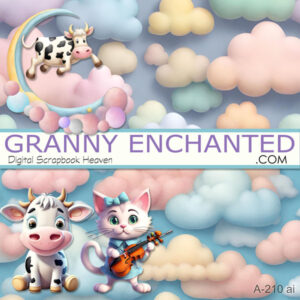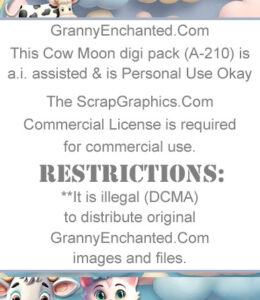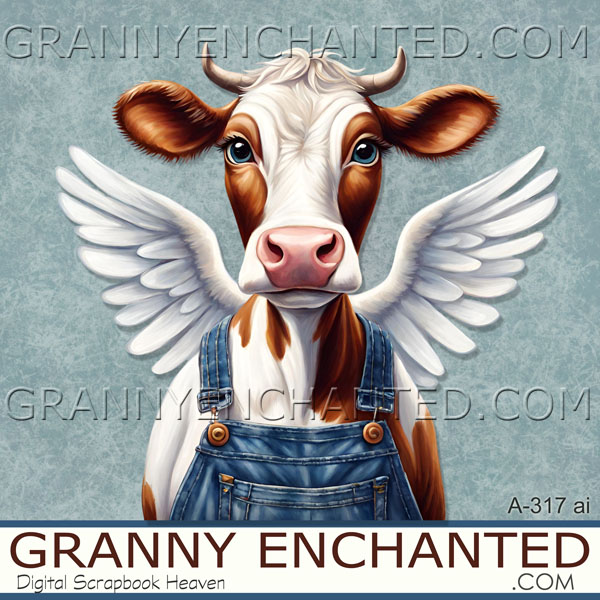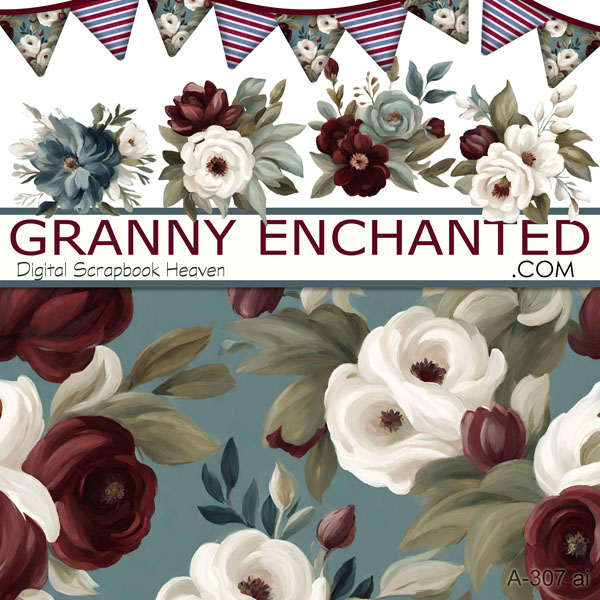Discover the whimsical charm of our digital scrapbook kit featuring the beloved nursery rhyme characters. The Cow Jumped Over the Moon clipart digital scrapbook kit includes a cow sitting and another jumping over the moon. In pastel blue, peach, pink, green, and yellow hues, this kit brings a playful vibe. the 3D cartoon animation style will win over your little ones. With two adorable cloud background papers at 12×12″ 300dpi each, your creations will pop. Perfect for baby scrapbook pages, shower invitations, and art projects, this mini kit promises endless creativity and joy.

Download this digital scrapbook kit HERE.
Where did this silly nursery rhyme come from anyway?
The story of “The Cow Jumped Over the Moon” originates from the English nursery rhyme “Hey Diddle Diddle.” It’s believed to have been passed down orally for generations before being recorded in print. The first print record of “Hey Diddle Diddle” can be traced back to the late 18th century. It was published in a compilation titled “Tommy Thumb’s Pretty Song Book,” dated around 1744.
Why is it good to entertain your children with nursery rhymes?
Telling children nursery rhymes has numerous benefits for their development. Firstly, nursery rhymes help children develop language skills by exposing them to rhythmic patterns, rhyming words, and vocabulary. These linguistic elements aid in phonemic awareness and literacy development (Wortham, 2008). Additionally, nursery rhymes often contain repetitive phrases, which reinforce memory and cognitive skills in young children (Mayo, 2004).
Moreover, nursery rhymes offer opportunities for social interaction and bonding between children and caregivers. Singing or reciting rhymes together fosters communication and strengthens relationships (Borgström, 2016). Furthermore, nursery rhymes contribute to cultural literacy by passing down traditional stories, values, and heritage from one generation to the next (Stewig & Jett-Simpson, 1992). They connect children to their cultural roots and create a sense of belonging.
Importantly, nursery rhymes stimulate creativity and imagination in children. The whimsical characters and fantastical scenarios encourage imaginative play and exploration (Mazzoni, 2017). Additionally, engaging with nursery rhymes promotes emotional development by allowing children to express feelings through music and rhythm (McCready, 2007). Overall, the rich oral tradition of nursery rhymes offers a holistic approach to early childhood education, encompassing language, social, cultural, cognitive, and emotional domains.
Sources:
- Borgström, M. (2016). ‘The cat’s got our tongue’: Embodied nursery rhymes and the experience of dementia. Ageing and Society, 36(4), 685-709.
- Mayo, A. Y. (2004). Language: A window into human nature. Cambridge, MA: MIT Press.
- Mazzoni, M. (2017). The role of rhymes in early childhood education: A methodological proposal. Journal of Education and Human Development, 6(1), 143-149.
- McCready, S. (2007). Music and emotion: Theory and research. New York, NY: Oxford University Press.
- Stewig, J. W., & Jett-Simpson, M. (1992). The power of literature: A multiple reading of five nursery rhymes. Language Arts, 69(1), 20-28.
- Wortham, S. E. (2008). Early childhood curriculum: Developmental bases for learning and teaching. Upper Saddle River, NJ: Pearson.






